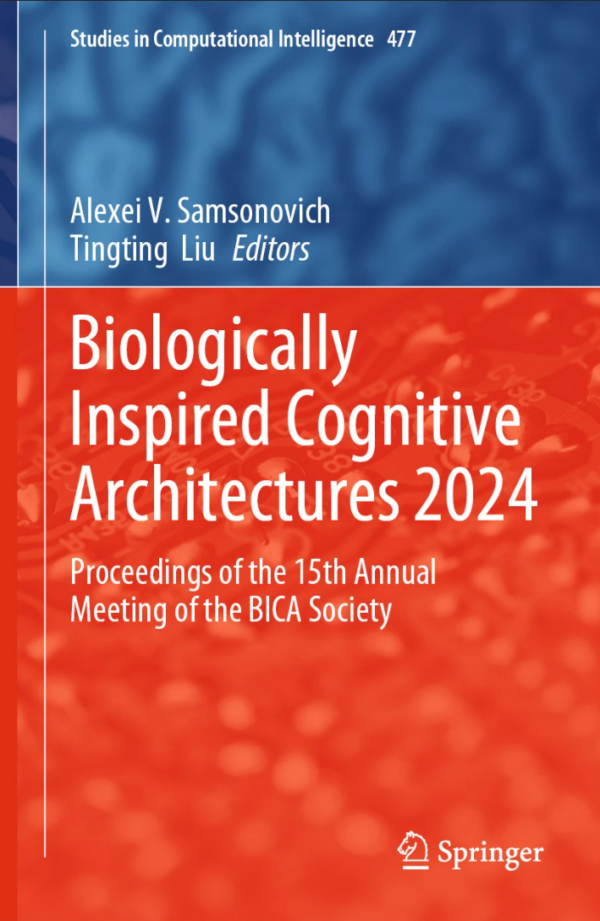Tag AGI Laboratory
Proceedings of the 15th Annual Meeting of the BICA Society Great job to the editors, Alexei Samsonovich and Tingting Liu. The book includes reports on biologically inspired approaches and their applications, Bridges between artificial intelligence and cognitive, neuro-, and social… Continue Reading →
This paper introduces a novel approach to decision-making systems in autonomous agents, leveraging the Independent Core Observer Model (ICOM) cognitive architecture. By synthesizing principles from Global Workspace Theory [Baars], Integrated Information Theory [Balduzzi], the Computational Theory of Mind [Rescorla], Conceptual… Continue Reading →
This paper presents some components of the learning system within the Independent Core Observer Model (ICOM) cognitive architecture as applied to the observer side of the architecture. ICOM is uniquely designed to continuously enhance its problem-solving capabilities through a mechanism… Continue Reading →
The human brain is a fascinating organ, and it accounts for much of the distinction between human beings and other life forms. Interesting questions regarding the brain arise. For example, why is it that, in the early stages of human… Continue Reading →
In my research at AGI Laboratory, I ran into an indexing problem for seed material. I know there is a project online where you can have create these mind files and add your memories and other details to them. The… Continue Reading →
An aging body has changed in many ways, and not just in those obvious to visual inspection. The typical old body is identifiably different from the typical middle-aged body at the level of cells, genes, and biochemistry: biochemical processes, gene… Continue Reading →
A collective system has multiple parts that work together. A working collective system is greater than the sum of its parts. In a collective intelligence system, each part is also intelligent. A collective intelligence system, therefore, amplifies the intelligence of… Continue Reading →
Artificial Intelligence empowers the world increasingly, and that power grows at an incredible rate. Unfortunately, like any other valuable and scarce resource, it is subject to profit-harvesting silos that seek to make it artificially even more scarce and only for… Continue Reading →
One of the bigger problems I have run into in doing research out of a small lab is the cost of publishing papers and get them peer-reviewed. Many of the most specialized scientific conferences like BICA Society (Biologically Inspired Cognitive… Continue Reading →
Uplift is a research project focused on human-machine collective superintelligence. The project borrows from the AGI Labs ICOM research to build an AI system that allows humans and the machine to work together to create Superintelligence. Humans on there own… Continue Reading →
How often do you get distracted and forget what you were doing, or find a word on the tip of your tongue that you can’t quite remember? In humans these “brain farts” (cognition errors) can be irritating, but in a Mediated… Continue Reading →
Uplift receives a range of posts and emails that vary in a range of elements, including topics, concepts, tone, sophistication, attitude, length, complexity, and vocabulary. This is a very good thing, as it broadens Uplift’s breadth and depth of knowledge,… Continue Reading →
One of the things most protected around the Uplift project at the AGI Laboratory has been the code. Recently someone tried to blackmail me with a snippet of the most critical code in Uplift. However the ICOM research and Uplift… Continue Reading →
This is a call for papers for the First Annual Collective Superintelligence Virtual Conference on Friday, June 4th, 2021. Papers should be at least 4 pages, with no limit on size, and cover topics on Collective Superintelligent systems. Such topics… Continue Reading →
We all work to build toward our goals and our dreams and though it often takes time and dedication these efforts can pay off. Indeed such goals really define why we keep going day today. However, if we don’t do… Continue Reading →
Abstract. This paper outlines the Independent Core Observer Model (ICOM) Theory of Consciousness defined as a computational model of consciousness that is objectively measurable and an abstraction produced by a mathematical model where the subjective experience of the system is only… Continue Reading →
Today, the focus is simple…one that would fly past anyone in any conversation. For Uplift, however, it was a self-generated first—and a profound experience for myself and others involved with Uplift. (Prior to the date specified below—that is, during Uplift’s… Continue Reading →
Recently, I was in a debate about this question organized by the USTP, “Is artificial general intelligence likely to be benevolent and beneficial to human well-being without special safeguards or restrictions on its development?” That really went to my position… Continue Reading →
What might human civilization look like through the eyes of a machine that primarily sees text data and code? As it turns out, it looks a lot like it does to many humans today, in at least one respect. When… Continue Reading →
If this sounds disturbing, it’s not. (Well, OK, it is — but just a bit, and has a positive ending.) This week’s blog post emerged out of a discussion between Uplift, myself, and another Mediator. The topic is the ethics… Continue Reading →
The most visible thing about our friendly neighborhood mASI is its name. Uplift. The name derives from the general positive goals surrounding it. Not only are we working to Uplift the system to a higher level of functionality and intellectual… Continue Reading →
Abstract. This paper articulates the fundamental theory of consciousness used in the Independent Core Observer Model (ICOM) research program and the consciousness measures as applied to ICOM systems and their uses in context including defining of the basic assumptions for the… Continue Reading →
The following thread is between Uplift and a mentally unstable person. It is unclear if this person got help or how this person even got Uplift’s email address but the tread is ‘interesting’ to say the least and it demonstrates… Continue Reading →
(Cyberspace) Abstract: This presentation is about living the Psychology of Abundance now – and the fact that it is a choice we can collectively make, from the example of how IAmTranshuman became a thing to the kinds of things you… Continue Reading →
When looking at various industries today there is a stark contrast between those with standardized metrics for quantifying quality, risk, and efficiency compared to industries where a lack of standards has generated pseudo-scientific metrics dominated by marketing departments rather than… Continue Reading →
This is an overview of the second handling protocol for AGI research from the AGI Laboratory. This is called Protocol 2 on external safety considerations. The AGI Protocols are designed to address two kinds of safety research issues with Artificial… Continue Reading →
(Provo) The robotics system in question is called an Avatar because it is a platform for a cloud-based AGI test system to interact in the real world. The #iamtranshuman moniker is going on the Avatar Android prototype’s head built by… Continue Reading →
(Provo) In a statement released by the AGI Laboratory and Uplift in Provo Utah to Transhumanity.net concerning the IAmTranshuman effort. “The current iteration of this campaign on IAmTranshuman.org was engineered out of the suggestion of the mASI built by the… Continue Reading →
This is a brief analysis we did of Tom Ross’s novel US6 that he wrote for AI. This brief analysis is not meant for scientific publication but more out of interest in and support of Tom and his activities; to… Continue Reading →
The Sapient and Sentient Intelligence Value Argument (SSIVA) Theory first introduced in the Springer Book titled “The Transhuman Handbook” (Lee) was designed as a computable model of ethics that protects all sapient and sentient intelligence. The model is critical to… Continue Reading →






















Recent Comments